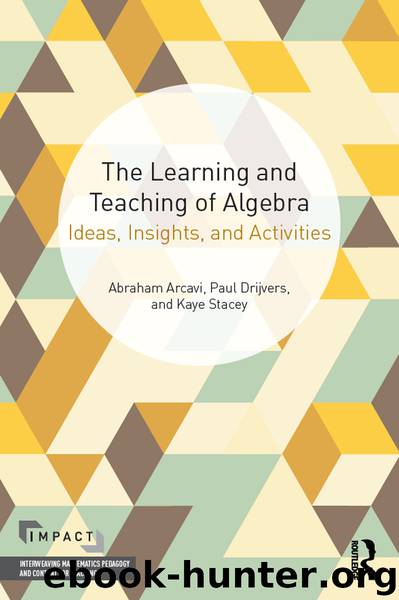The Learning and Teaching of Algebra by Arcavi Abraham; Drijvers Paul; Stacey Kaye

Author:Arcavi, Abraham; Drijvers, Paul; Stacey, Kaye
Language: eng
Format: epub
ISBN: 4568545
Publisher: Routledge
3.9 Chapter Summary
Algebra involves a new way of thinking that requires substantial change of perspective, alongside the considerable manipulative rule-based skills required to deal fluently and accurately with its notation. Students come to algebra after learning arithmetic, which of course provides essential skills for doing algebra. Perhaps surprisingly, however, the transition from arithmetic to algebra is not a smooth one. It is not just that the new algebra ideas are hard; it is also that many of the well-established ideas from arithmetic apply, but only when given an unfamiliar twist. Beginning students also bring to the learning of algebra their ideas about letters in other forms of writing. Algebra is a language particularly suited to explicitly describing mathematical relationships and structure. This too is a new orientation for students, who have previously dealt with structure only intuitively.
As students learn algebra, they need to go through several cycles where mathematical processes are turned into mathematical objects. As they put on the new algebra spectacles, they begin to see algebraic entities that they could not see before. The first is that algebraic expressions need to be seen as objects, rather than as instructions for what to do with a number. Then equations have to change from a shorthand way of writing mathematical facts, to mathematical objects which themselves can be operated upon. Functions similarly are first encountered as rules for transforming numbers, but later become objects in their own right which have properties and can be transformed and combined to form other functions. Many entities in all branches of mathematics are created in this way.
This chapter has reviewed some of the transitions that students need to make to move to the new way of thinking. Knowledge of what students bring to algebra can help teachers address issues that underlie student difficulties. Both students and their teachers have to work hard so that students can learn to see through their new very powerful algebra spectacles.
Download
This site does not store any files on its server. We only index and link to content provided by other sites. Please contact the content providers to delete copyright contents if any and email us, we'll remove relevant links or contents immediately.
| Administration | Assessment |
| Educational Psychology | Experimental Methods |
| History | Language Experience Approach |
| Philosophy & Social Aspects | Reform & Policy |
| Research |
The Art of Coaching Workbook by Elena Aguilar(50094)
Trainspotting by Irvine Welsh(21008)
Twilight of the Idols With the Antichrist and Ecce Homo by Friedrich Nietzsche(18292)
Fangirl by Rainbow Rowell(8782)
Periodization Training for Sports by Tudor Bompa(7906)
Change Your Questions, Change Your Life by Marilee Adams(7360)
This Is How You Lose Her by Junot Diaz(6427)
Asking the Right Questions: A Guide to Critical Thinking by M. Neil Browne & Stuart M. Keeley(5349)
Grit by Angela Duckworth(5292)
Red Sparrow by Jason Matthews(5190)
Paper Towns by Green John(4785)
Room 212 by Kate Stewart(4728)
Ken Follett - World without end by Ken Follett(4437)
The Sports Rules Book by Human Kinetics(4069)
Housekeeping by Marilynne Robinson(4056)
Double Down (Diary of a Wimpy Kid Book 11) by Jeff Kinney(3915)
Papillon (English) by Henri Charrière(3896)
Exercise Technique Manual for Resistance Training by National Strength & Conditioning Association(3778)
The Motorcycle Diaries by Ernesto Che Guevara(3775)
